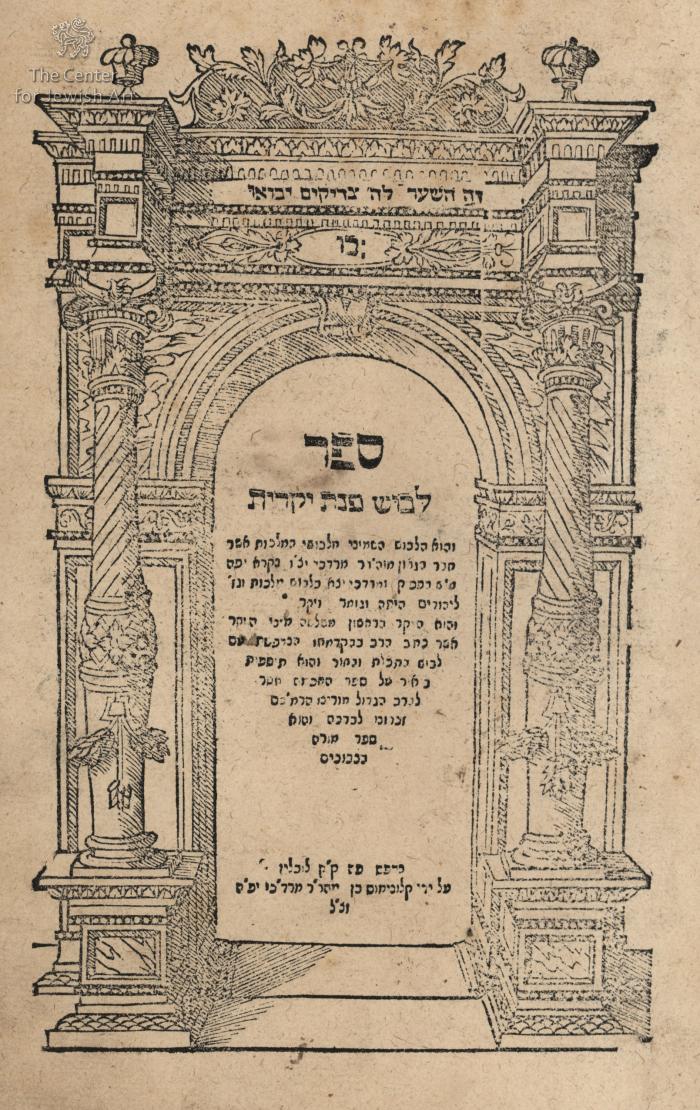Obj. ID: 36238
Jewish printed books Levush Pinat Yikrat by Mordechai ben Avraham Jaffe, Lublin, 1595

This text was prepared by William Gross:
A commentary on Maimonides' Guide for the Perplexed, and one of the three "Levushim" that together comprise the Levush Or Yikrat.
R. Jaffe is best known for his “Levushim,” a ten-volume codification of Jewish law that particularly stressed the customs of the Jews of Eastern Europe. From this work he is known as "the Levush". The first five “Levushim” comprise halakhic codes in the order of the Turim of R. Jacob b. Asher; the other five (including the present volume) contain commentaries and sermons.
Decorative title page with columned gateway.
Mordecai ben Avraham Jaffe (c. 1530, Prague – March 7, 1612, Posen; Hebrew: מרדכי בן אברהם יפה) was a Rabbi, Rosh Yeshiva and posek. He studied under Moses Isserles and Solomon Luria. He also studied philosophy, astronomy, and mathematics (apparently at the instance of R. Isserles). He was Rosh Yeshiva in Prague until 1561, when, by order of the emperor Ferdinand, the Jews were expelled from Bohemia. R. Jaffe then went to Venice and studied astronomy (1561-71). In 1572 he was elected rabbi of Grodno; in 1588, rabbi of Lublin, where he became one of the leaders of the Council of Four Lands. Later Jaffe accepted the rabbinate of Kremenetz. In 1592 he was called as rabbi to Prague; from 1599 until his death he occupied the position of chief rabbi of Posen.
While still in his youth, R. Jaffe had the idea to compile a book on Jewish law, which would be used for making halachic decisions. The appearance of Caro's Shulchan Arukh, a digest of his Beit Yosef, led R. Jaffe to consider whether he should continue writing his own work. On reflection, he concluded that there was room for it since it would contain "those laws observed by the Ashkenazi Jews of Bohemia." When Moshe Isserles' Gloss to the Shulḥan Arukh (called Mappah) appeared in Cracow in 1578, Jaffe felt that Isserles had been too brief as had Caro in the Shulḥan Arukh, and decided to resume his original work, "that will be midway between the two extremes: the lengthy Beit Yosef of Caro on the one hand, and on the other Caro's Shulḥan Arukh together with the Mappah of Isserles, which is too brief." In all, Jaffe worked on this book almost 50 years. However, after completing it he was confronted by another Rabbi who had also written a similar work, although not as extensive as Jaffe's. They reached an agreement to publish Jaffe's book and to present the other Rabbi's additional comments in glosses (hagahos) throughout the book [see introduction to his Levush].
The printer Kalonymous b. Mordechai Jaffe was a second cousin of R. Jaffe. Already active in Lublin beginning in the 1550's, the press in which he was a partner was idle during from 1582-1589 due to competition from the Prostitz press in Cracow. In 1590, however, Kalonymous acquired new typographical material and began to print again. In 1592 the press took refuge in the village of Bistrowitz, on the outskirts of the city, due to an outbreak of plague. When the plague ceased shortly afterwards, the press returned to Lublin, and the press resumed activity, beginning with the Levush Or Yikrat, a collection of three Levushim: Levush Even ha-Yekarah, on Menaḥem Recanati’s kabbalistic Torah commentary, Levush Eder ha-Yakar, a commentary on Maimonides’ Laws of the Sanctification of the New Moon and explanation of Avraham bar Ḥiya’s Tsurat ha-arets, on astronomy, and the present volume, Levush Pinat Yikrat.



